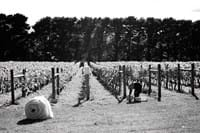Elevated vines, exceptional wines
The nitty-gritty on why our wine tastes so good
We may be less well known than other wine regions, but that doesn’t stop us from producing some of the best cool climate wines in Australia. With vineyards at altitudes ranging from 300-800 metres, we’re categorized as a cool to cold climate—making it an ideal location for a number of varietals.
Pinot Noir, Chardonnay and Sparkling Wines are what we’re most known for—and we do those exceptionally well—but that’s not all we make. In the northern part of the region, you’ll also find big, robust reds including Shiraz and Cabernet, and in much of the region, a number of aromatic whites, like Riesling and Gewürztraminer.
Cool and youthful
We’re a pretty young region, as wine regions go. Although the very first vines were planted in the region in the 1860’s, the modern Macedon Ranges wine industry really got going in the 1970’s.
In the late 1960s, plantings were made at Virgin Hills by Tom Lazar and, in 1971, at Baynton by Gordon Knight (Granite Hills). This was followed in 1977 by Gordon Cope-Williams’ plantings at Romsey, Bob Nixon’s planting of Gisborne Peak Winery at Gisborne South in 1978 and the establishment of Hanging Rock, Rochford, Portree and Roseberry Hill in 1983.
Now there are over 40 vineyards in the region which continue to develop and grow.
The ground beneath us
Wondering what makes the Macedon Ranges such a cool place? It’s all thanks to the region’s topography: the extinct volcanoes of the Great Dividing Range in the South and West, the granite boulders of the Cobaw Range in the North and the slate and gold-bearing gravels to the North West. The region’s 40+ vineyards are cradled between 300 and 800 metres above sea level. It really is no wonder this region remains so cool throughout the year.
For a relatively small geographic area, we’ve got a lot going on geo-climate-wise. Across our region you’ll find five distinct geo-climatic zones:
- High vineyards at 650-800m altitude on the Great Dividing Range from Mount Macedon to beyond Trentham (see regional map) have the coldest hours during the ripening period and low heat loads during summer
- Central vineyards can be cold with air down-flowing from surrounding ridges
- Western vineyards on the north western side of the Great Dividing Range have somewhat milder summer nights and warmer days as some are sheltered from cold westerly winds
- Southern vineyards south of Mt. Macedon are warmer due to the closeness to the ocean
- Northern vineyards are exposed to northerly winds, they have the lowest amount of cold degree hours.
We’ve got good dirt
Actually, that’s not quite true. Grapes don’t do so well in good soil. If the soil’s too fertile, the vines become over-vigorous, producing grapes with little colour or flavour—not conducive for winemaking. Luckily, we don’t have that problem.
The majority of our soils are sandstone and shales which form the gentle rounded hills punctuated by the steeper and higher granitic hills of the Cobaw ranges and the volcanic Mt Macedon, Mt Gisborne and Mt Bullengarook in the south.
The soils derived from sandstone and shales are predominantly low fertility acidic duplex shallow brown-yellow clay loams. The clay helps to keep the loam less fertile, allowing us to produce high-quality grapes and award-winning wines. The granitic outcrops in the Cobaw ranges and parts of Mt Macedon are predominantly free draining uniform or gradational sandy to stony shallow loams. These soils act to restrict yield—and produce complex, peppery Shiraz.
Lastly, the volcanic soils around Romsey, to the south and east of Gisborne and north of Woodend are rich gradational and sometimes red friable clay soils. Volcanic soils help to retain water, which is always a good thing here in Australia.





